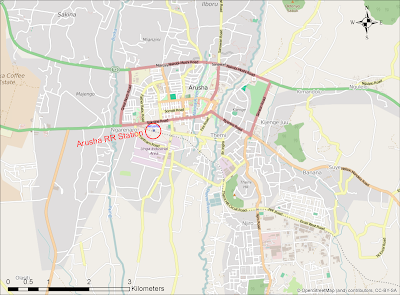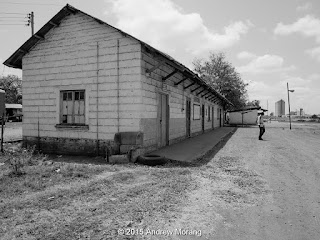Arusha is a bustling commercial city in north central Tanzania. It is not a tourist destination in itself, but is certainly worth a day or two of exploring. The central market in any city is worth a visit. This one was a bit smaller then I expected, and seemed quiet, but possibly my friends and I arrived too late in the day for the main action. The produce looks good!
Some big beefy ladies haunt the market district.
The market is next to the bus station, which is really active. There is no train service to Arusha now, but by bus you can go to Kenya or Uganda, and possibly further. That might be an interesting adventure.
A surprising number of merchants downtown were Indians (or Pakistanis?). We heard that many are descendants of Indian troops who were sent to Tanganyika in the early-20th century. When Britain gave up its colony, the former troopers stayed behind (or were left behind). Is this story true? In neighboring Uganda, the business class during the mid-20th century was dominated by Indians. Dictator Idi Amin (the "Butcher of Uganda") expelled the Indian traders, bankers, and merchants, and Uganda's economy virtually collapsed. (This sounds like the folly of Ferdinand and Isabella in expelling the Jews from Spain in the late-1400s - stupidity cloaked in religion.)
We came across a building with post office boxes, not a post office, just hundreds of boxes.
Near the bus station is a large and lonely cemetery. In the colonial era, it may have been the European cemetery. Sadly, it is neglected now.
On a clear day, Mount Meru looms over the city. Meru is a stratovolcano with peak elevation of 4,562.13 metres (14,968 ft). Our guide said there are climbing routes but it is not a common tourist destination.
We looked for English cultural remains, but I was surprised how few English buildings were left. This long colonnaded building was in the grounds of the Mount Meru Regional Hospital. Rangoon (see my Burma blog posts) has a much richer colonial architectural legacy.
This is the fourth of a series of Tanzania articles and has covered a short tour of Arusha. Should your travels take you there, do walk or take motorbikes round town.
Photographs taken with a Panasonic Lumix G3 digital camera with Panasonic 12-32mm lens. I opened the raw files with Adobe Camera Raw 7.4 and processed most of the frames with DxO FilmPack 5 using the Kodachrome 25 emulation. I think it does not quite look like Kodachrome, but have no direct comparison available.





































